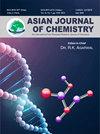镁粉催化下通过胺的 N-乙酰化无溶剂高效合成酰胺及其抗菌活性
Q4 Chemistry
引用次数: 0
摘要
研究发现,镁粉是用 Ac2O 对胺(1)进行乙酰化的高效催化剂,能以极高的产率(> 99%)生成相应的酰胺(2)。这一绿色合成方案使用了 2.5 摩尔% 的镁粉和等量的 Ac2O(1.2 等量)。酰胺 2a-k 是在无溶剂的环境温度下,在很短的反应时间(2-3 分钟)内合成的。针对大肠杆菌、铜绿假单胞菌、金黄色葡萄球菌和表皮葡萄球菌等细菌菌株对产品进行了筛选。结果发现,N-(2-羟基苯基)乙酰胺(2f)对革兰氏阳性的金黄色葡萄球菌和表皮葡萄球菌最有效,这表明它在治疗皮肤病方面的功效。本文章由计算机程序翻译,如有差异,请以英文原文为准。
Magnesium Powder-Catalyzed, Highly Efficient, Solvent-Free Synthesis of Amides through N-Acetylation of Amines and their Antibacterial Activity
Magnesium powder was found to be an efficient catalyst for the acetylation of amines (1) with Ac2O affording corresponding amides (2) in excellent yields (> 99%). This green synthetic protocol has utilized 2.5 mol% of magnesium powder and a stoichiometric amount of Ac2O (1.2 equiv.). Amides 2a-k were synthesized within a short reaction time (2-3 min) at an ambient temperature under solvent free condition. The products were screened against Escherichia coli, Pseudomonas aeruginosa, Staphylococcus aureus and Staphylococcus epidermidis bacterial strains. N-(2-Hydroxyphenyl)acetamide (2f) was found most active against Gram-positive S. aureus and S. epidermidis indicating its efficacy in treating skin diseases.
求助全文
通过发布文献求助,成功后即可免费获取论文全文。
去求助
来源期刊

Asian Journal of Chemistry
化学-化学综合
CiteScore
0.80
自引率
0.00%
发文量
229
审稿时长
4 months
期刊介绍:
Information not localized
 求助内容:
求助内容: 应助结果提醒方式:
应助结果提醒方式:


